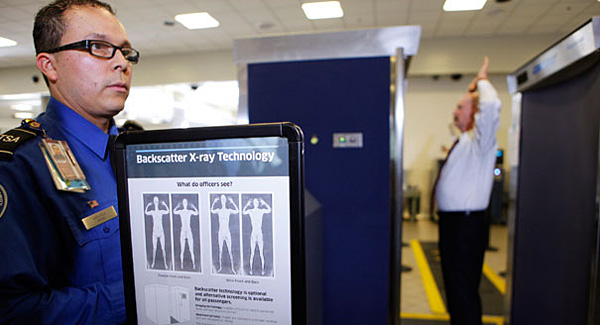
|  |  |  Editorials | Issues Editorials | Issues  
The Naked Truth About Scanners
 Roger Simon - Politico Roger Simon - Politico
go to original
December 29, 2010


| |
By New Year’s Day, there will be 500 airport full-body scanners in use nationwide.(Associated Press) |  |
On the day after Christmas, readers of The Washington Post were given a real treat: pictures of naked men.

The men in the pictures were fully clothed, but they were naked nonetheless, because the pictures came from airport full-body scanners.

The machines provided graphic pictures of the male anatomy. True, they were no more graphic than Michelangelo’s David or Leonardo da Vinci’s Vitruvian Man (that’s the naked guy with his arms and legs stuck out), but both of those were depictions, not actual people trying to heft their wheelie bags on the conveyor belt, take off their shoes and jackets, remove their laptops, take out their baggies full of fluids no more than 3 ounces in size, take the metal out of their pockets and somehow get through security before their planes take off.

According to the Post, by New Year’s Day, there will be 500 such machines in use nationwide and 1,000 by the end of 2011, or roughly one machine for every two security lanes in every airport in the land.

If the machines offend your sense of modesty or decency for yourself or your children, then you can request a pat-down where your naughty bits may be touched by a Transportation Security Administration screener rather than projected on a video screen.

Officials say 98 percent of people go through the machines rather than request a pat-down, which is not surprising: First, who likes to be touched by a stranger? And second, going through the machines is faster, and flying has becomes such a cumbersome and aggravating experience that most people will do anything to get it over with.

(There is a company called Flying Pasties, which claims to have a product that you slip inside your clothing to screen your private parts. “It’s simply not against the law to keep your private parts private,” the company says.)

Some parties are suing the government over the new machines, claiming an unreasonable invasion of privacy, while others claim the machines expose people to too much radiation, which the government denies.

Most people, however, accept it as just another agony associated with flying (along with fees to check baggage and crowded luggage bins).

And, after all, the machines are worth it because they detect explosives.

Except they don’t. As it turns out, the machines don’t detect explosives at all. They detect images on your body that shouldn’t belong on your body.

“It’s not an explosive detector; it’s an anomaly detector,” Clark Ervin, who runs the Homeland Security Program at the Aspen Institute, told the Post. “Someone has to notice that there’s something out of order.”

Which means those security employees who stare at the screens have to be sharp enough and well-trained enough to detect things that are abnormal. (And some experts think that if the explosives are flat and pancake-shaped and taped to your stomach, they could not be detected anyway, because the picture would look too normal.)

The machines cost $130,000 to $170,000 each, and by 2014, the federal government will have spent $234 million to $300 million for them.

Which would be a bargain if they actually did something besides embarrass people. In May, a TSA screener at Miami International Airport who went through a full-body screening as part of his training was arrested for beating a co-worker with a police baton after co-workers made fun of the size of his private parts.

The solution for passengers? Get used to it.

Janet Napolitano, the secretary of homeland security, was interviewed Sunday by CNN’s Candy Crowley, and Napolitano said nothing was going to change “for the foreseeable future.”

“You know, we’re always looking to improve systems and so forth,” Napolitano said. “But the new technology, the pat-downs, is just objectively safer for our traveling public.”

But Crowley decided to screen and pat down that assertion.

Citing an ABC report, Crowley said, “There are some major airports who had a 70 percent failure rate at detecting guns, knives, bombs, that they got through in your tests…. So how good can it be when you have major airports with a 70 percent fail rate?”

Napolitano dismissed those results as old and questionable and said, “Let’s set those aside.” One of the real successes of the machines and procedures, Napolitano said, is that they discourage terrorists from even trying to get on planes.

In other words, the machines keep us safe even if they don’t work at all.

“What we know is that you can’t measure [how] the devices … are deterring [terrorists] from going on a plane,” Napolitano said.

“Just people who just are discouraged, thinking they’d be found out,” said Crowley.

“Exactly,” said Napolitano.

In which case, we do not need machines that cost upward of $130,000 each.

All we need are archways made out of $30 or $40 worth of sheet metal that are labeled: “Official Destructo Machine — If You Are a Terrorist, This Machine Will Not Only Zap You, but Put a Picture of Your Private Parts on YouTube.”

That ought to do it. |

 |
|  |



